New Smart Sensor for Voltage Unbalance Measurements in Electrical Power Systems
Abstract
1. Introduction
- Proposing a new methodology to quantify the voltage unbalance based on measuring the DC voltage at the output of three-phase diode bridge rectifiers, instead of the three alternating current (AC) voltages (phase-to-neutral or phase-to-phase voltages), as currently used in the literature.
- Proposing a new definition of voltage unbalance factor based on time, considering the measured DC voltage, unlike existing methods in the literature, which propose the phase-to-neutral or phase-to-phase voltage measurements.
2. Definitions of Voltage Unbalance Factors
2.1. Ratio between the Negative-Sequence Component and the Positive-Sequence Component
2.2. Ratio between the Maximum Phase-to-Phase Voltage Deviation from the Average Phase-to-Phase Voltage and the Average Voltage
2.3. Ratio between the Maximum Phase Voltage Deviation from the Average Phase Voltage and the Average Voltage
2.4. Ratio between the Maximum Phase Voltage Deviation from the Minimum Phase Voltage and the Average Voltage
2.5. Discussion about the Definitons of Voltage Unbalance
3. Proposal of a New Methodology to Measure the Voltage Unbalance Factor (VUF) According to EN 50160
- To compare the measured DC voltage with the predicted DC voltage (the latter is obtained in Equation (19), step 7). If the difference between these values is lower than a predefined error ε, (in this application, an error ε = 5% has been considered), the measured value is valid and the method continues to step 2; otherwise, the measured value is not valid (e.g., due to a malfunction in the sensor, etc.) and a new comparison is made between the next DC measured value and the predicted DC value.
- To compute 3 consecutive maximum values and 4 consecutive maximum values in the DC voltage measurement, with their corresponding time values. Figure 3 depicts this idea by showing the voltage profile that corresponds to the DC side of the rectifier when its AC side is fed with a one-phase voltage drop of 5% (in phase-a voltage) with respect to its rated value (100 V, 50 Hz). Note that the time lapse from the first minimum value to the fourth minimum value corresponds to a semi-period of the AC voltages (i.e., tmin 4 − tmin 1 = T/2). In Figure 3, the semi-period corresponds to 10 ms, because the rated frequency is 50 Hz.
- To repeat 10 times over time the measurement explained in step 2 (so M1, M2, … M10 measurements are obtained). Table 3 shows the 10 measurements that correspond to the DC voltage profile depicted in Figure 3. It should be noted that every time that a measurement Mi is made, it is stored in the memory of the smart sensor, and every 5 cycles this table is fully updated with 10 new measurements.
- To determine the average maximum values of the DC voltage (Vmax 1, Vmax 2, Vmax 3) as:
- 5.
- To obtain the VUF by means of Equation (3), though β is not obtained from the phase-to-phase voltages (as shown in Equation (4)), but from the maximum values obtained in step 4, according to Equation (10), so:
- 6.
- To reconstruct the phase-to-phase voltage phasors in tmin 1 (from the last measurement, M10). Figure 4 shows the phasor diagram of phase-to-phase voltages, i.e., at tmin 1 (M10). It should be pointed out from this figure that the phasor has an angle of π/2 rad, which matches with Figure 3, where the time evolution of the phase-to-phase bc voltage (cosine function) has an angle of π/2 rad at t = tmin 1.
- 7.
4. Methodology Validation
4.1. Simulation Results
- Main grid with rated values 100 V and 50 Hz. The following unbalanced scenario in supplied voltages by the grid has been simulated: Va = 105 V, Vb = 100 V, Vc = 95 V.
- Three-phase diode bridge rectifier.
- Proposed smart sensor, where the methodology explained in Section 3 has been implemented in Matlab-SimulinkTM blocks. Note that the proposed smart sensor only measures the DC link, unlike existing sensors, which measure three voltages (either phase-to-phase or phase-to-neutral voltages). The VUF has been calculated according to Equations (3) and (4) (see the proposed methodology in Section 3).
- Existing three-phase sensors, which measure phase-to-phase voltages. The VUF has been calculated according to Equations (3) and (4).
4.2. Experimental Results
5. Proposal of a New Voltage Unbalance Factor
6. Conclusions
Author Contributions
Funding
Institutional Review Board Statement
Informed Consent Statement
Acknowledgments
Conflicts of Interest
List of Abbreviations
| AC | Alternating current. |
| DC | Direct current. |
| LVUR | Line voltage unbalance ratio (according to NEMA MG1). |
| PCC | Point of common coupling. |
| PVUR | Phase voltage unbalance ratio (according to IEEE Std. 141). |
| PVUR’ | Phase voltage unbalance ratio (according to IEEE Std. 936). |
| RMS | Root mean square. |
| VUF | Voltage unbalance factor (according to EN 50160). |
| VUF’ | Voltage unbalance factor (according to CIGRE and IEEE Std. 1159). |
| VUFT | Voltage unbalance factor according to time (proposed factor). |
References
- EN 50160:2010; Voltage Characteristics of Electricity Supplied by Public Electricity Networks. CENELEC: Brussels, Belgium, 2010.
- IEEE 1159-2019; IEEE Recommended Practice for Monitoring Electric Power Quality. IEEE: New York, NY, USA, 2019. [CrossRef]
- Electric Power Research Institute. Voltage Unbalance: Power Quality Issues, Related Standards and Mitigation Techniques. Effect of Unbalanced Voltage on End Use Equipment Performance; Technical Report; EPRI: Palo Alto, CA, USA, 2000; Available online: https://www.epri.com/research/products/000000000001000092 (accessed on 12 September 2022).
- IEC 60038:2009; IEC Standard Voltages. IEC: Geneva, Switzerland, 2009.
- IEC 61000-4-27:2000; Electromagnetic Compatibility (EMC). Part 4-27: Testing and Measurement Techniques. Unbalance, Immunity Test. IEC: Geneva, Switzerland, 2000.
- IEC 61000-4-30:2015; Electromagnetic Compatibility (EMC). Part 4-30: Testing and Measurement Techniques. Power Quality Measurement Methods. IEC: Geneva, Switzerland, 2015.
- NEMA MG1-2021; Motors and Generators. NEMA: Arlington, VA, USA, 2021.
- Fortescue, C.L. Polyphase power representation by means of symmetrical coordinates. J. Am. Inst. Electr. Eng. 1920, 39, 543–544. [Google Scholar] [CrossRef]
- Eugène, C. A new simple and effective approximate formulation for the determination of three-phase unbalances by the voltmeter method. In Proceedings of the International Conference on Large High Voltage Electric Systems (CIGRE), Paris, France, 27 August–4 September 1986. [Google Scholar]
- Jeong, S.G. Representing line voltage unbalance. In Proceedings of the 2002 IEEE Industry Applications Conference, 37th IAS Annual Meeting, Pittsburgh, PA, USA, 13–17 October 2002. [Google Scholar] [CrossRef]
- Ghijselen, J.A.L.; Van den Bossche, A.P.M. Exact voltage unbalance assessment without phase measurements. IEEE Trans. Power Syst. 2005, 20, 519–520. [Google Scholar] [CrossRef]
- Chen, T.H.; Yang, C.H.; Yang, N.C. Examination of the definitions of voltage unbalance. Int. J. Electr. Power Energy Syst. 2013, 49, 380–385. [Google Scholar] [CrossRef]
- Faiz, J.; Ebrahimpour, H.; Pillay, P. Influence of unbalanced voltage on the steady-state performance of a three-phase squirrel-cage induction motor. IEEE Trans. Energy Convers. 2004, 19, 657–662. [Google Scholar] [CrossRef]
- Faiz, J.; Ebrahimpour, H. Precise derating of three-phase induction motors with unbalanced voltages. In Proceedings of the 2005 IEEE Industry Applications Conference, 40th IAS Annual Meeting, Hong Kong, China, 2–6 October 2005. [Google Scholar] [CrossRef]
- Gnacinski, P. Windings temperature and loss of life of an induction machine under voltage unbalance combined with over- or undervoltages. IEEE Trans. Energy Convers. 2008, 23, 363–371. [Google Scholar] [CrossRef]
- Campbell, M.; Arce, G. Effect of motor voltage unbalance on motor vibration: Test and evaluation. IEEE Trans. Ind. Appl. 2018, 54, 905–911. [Google Scholar] [CrossRef]
- Lee, C.Y.; Chen, B.K.; Lee, W.J.; Hsu, Y.F. Effects of various unbalanced voltages on the operation performance of an induction motor under the same voltage unbalance factor condition. Electr. Power Syst. Res. 1998, 47, 153–163. [Google Scholar] [CrossRef]
- Mantilla, L.F. An analytical and graphical study of the symmetrical components in an induction motor supply in relation to the voltage unbalance parameters. Electr. Eng. 2007, 89, 535–545. [Google Scholar] [CrossRef]
- Wang, Y.J. Analysis of effects of three-phase voltage unbalance on induction motors with emphasis on the angle of the complex voltage unbalance factor. IEEE Trans. Energy Convers. 2001, 16, 270–275. [Google Scholar] [CrossRef]
- Singh, S.B.; Singh, A.K.; Thakur, P. Assessment of induction motor performance under voltage unbalance condition. In Proceedings of the IEEE 15th International Conference on Harmonics and Quality of Power, Hong Kong, China, 17–20 June 2012. [Google Scholar] [CrossRef]
- Quispe, E.C.; López-Fernández, X.M.; Mendes, A.M.S.; Marques-Cardoso, A.J.; Palacios, J.A. Experimental study of the effect of positive sequence voltage on the derating of induction motors under voltage unbalance. In Proceedings of the 2011 IEEE International Electric Machines & Drives Conference (IEMDC), Niagara Falls, ON, Canada, 15–18 May 2011. [Google Scholar] [CrossRef]
- Adekitan, A.I. A new definition of voltage unbalance using supply phase shift. J. Control Autom. Electr. Syst. 2020, 31, 718–725. [Google Scholar] [CrossRef]
- Von Jouanne, A.; Banerjee, B. Assessment of voltage unbalance. IEEE Trans. Power Deliv. 2001, 16, 782–790. [Google Scholar] [CrossRef]
- Gopalan, S.; Vasudevan, K.; Kumar, D.; Shanmugam, P. Impact of supply voltage unbalance and harmonics on DC bus electrolytic capacitor of adjustable speed drives. IEEE Trans. Ind. Appl. 2020, 56, 3819–3830. [Google Scholar] [CrossRef]
- Silva, M.D.C.; Ferreira-Filho, A.L. An alternative methodology for quantifying voltage unbalance based on the effects of the temperatures and efficiency of induction motors. IEEE Access 2022, 10, 83567–83579. [Google Scholar] [CrossRef]
- Vieira, F.L.; Santos, P.H.M.; Carvalho-Filho, J.M.; Leborgne, R.C.; Leite, M.P. A voltage-based approach for series high impedance fault detection and location in distribution systems using smart meters. Energies 2019, 12, 3022. [Google Scholar] [CrossRef]
- Tangsunantham, N.; Pirak, C. Voltage unbalance measurement in three-phase smart meter applied to AMI systems. In Proceedings of the 10th International Conference on Electrical Engineering/Electronics, Computer, Telecommunications and Information Technology, Krabi, Thailand, 15–17 May 2013. [Google Scholar] [CrossRef]
- Fortescue, C.L. Method of symmetrical co-ordinates applied to the solution of polyphase networks. AIEE Trans. 1918, 37, 1027–1140. [Google Scholar] [CrossRef]
- IEEE 141-1993; IEEE Recommended Practice for Electric Power Distribution for Industrial Plants. IEEE: New York, NY, USA, 1994. [CrossRef]
- IEEE 936-1987; IEEE Guide for Self-Commutated Converters. IEEE: New York, NY, USA, 1987. [CrossRef]
- Saura-Perisé, J.; Bakkar, M.; Bogarra, S. New methodology to calculate DC voltage signature in n-phases TRUs under supply voltage sags. IEEE Access 2022, 10, 20199–20211. [Google Scholar] [CrossRef]
- Saura, J.; Mesas, J.J.; Sainz, L. Average value of the DC-link output voltage in multi-phase uncontrolled bridge rectifiers under supply voltage balance and unbalance conditions. Electr. Eng. 2021, 103, 3097–3109. [Google Scholar] [CrossRef]
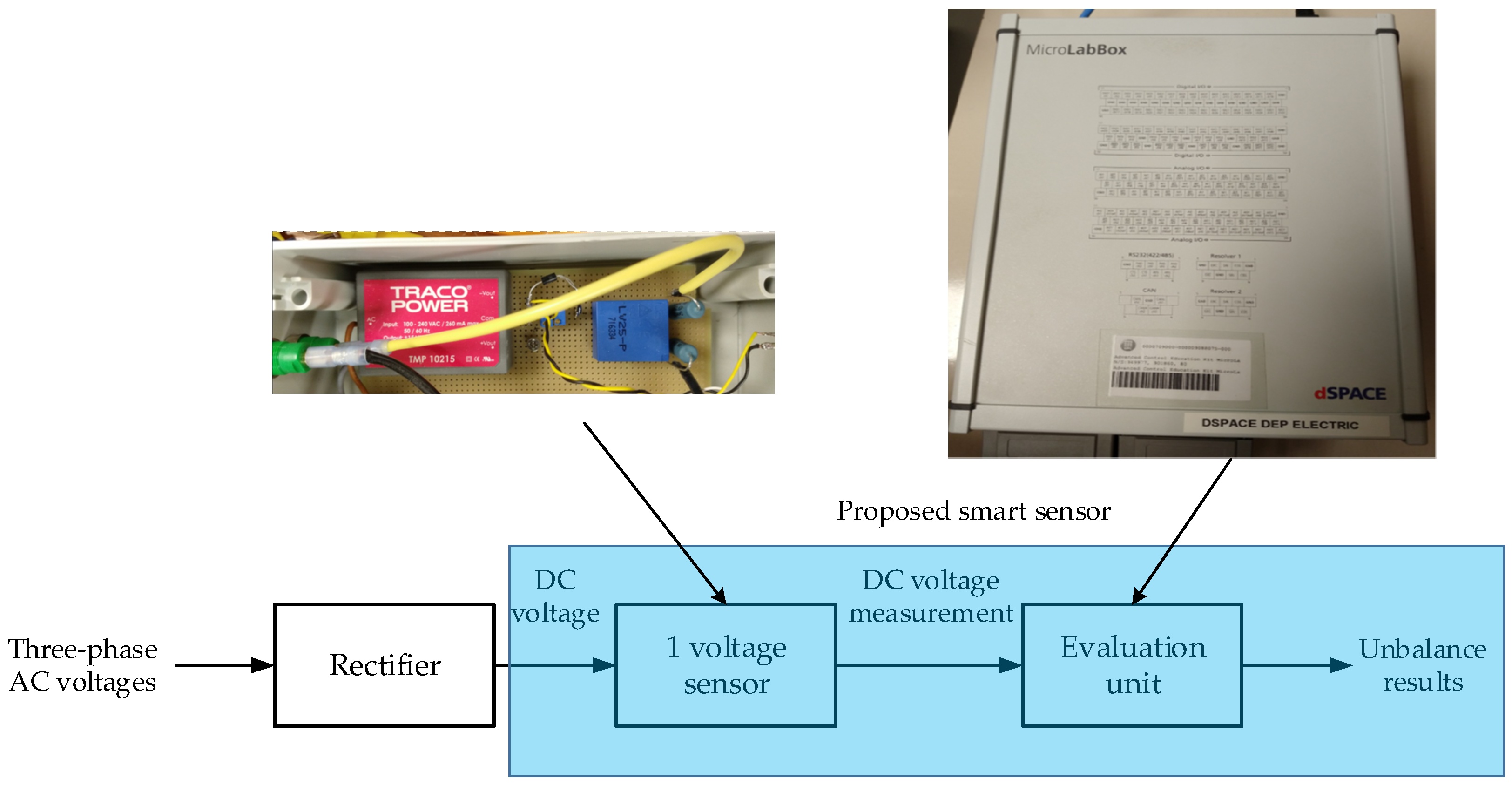


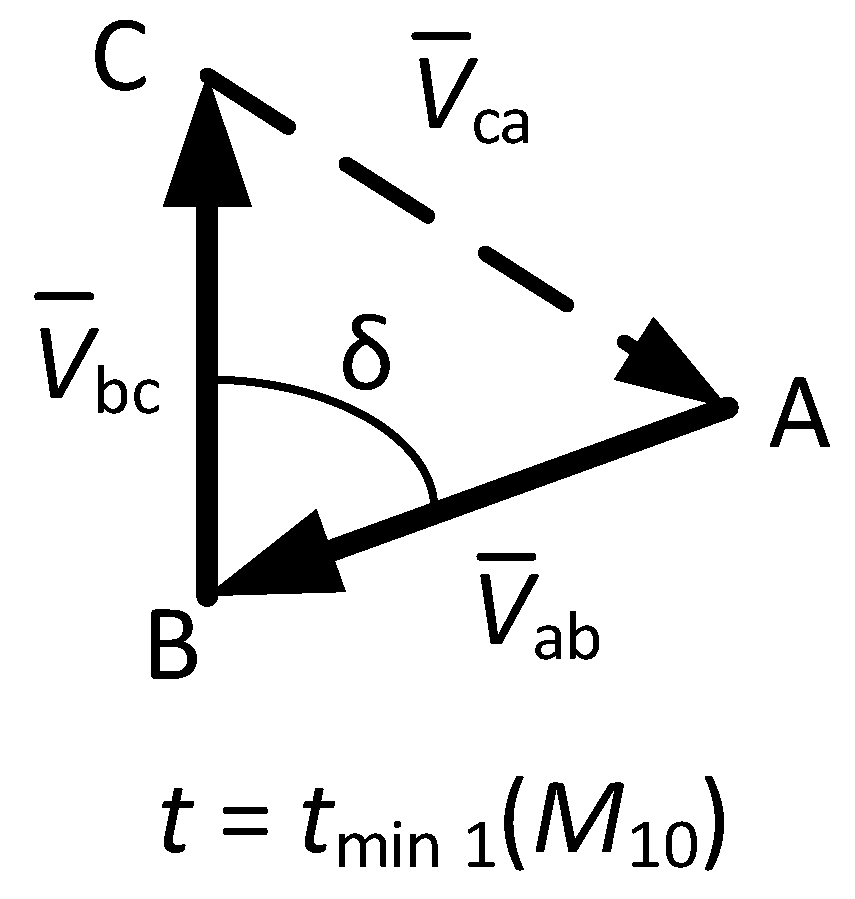

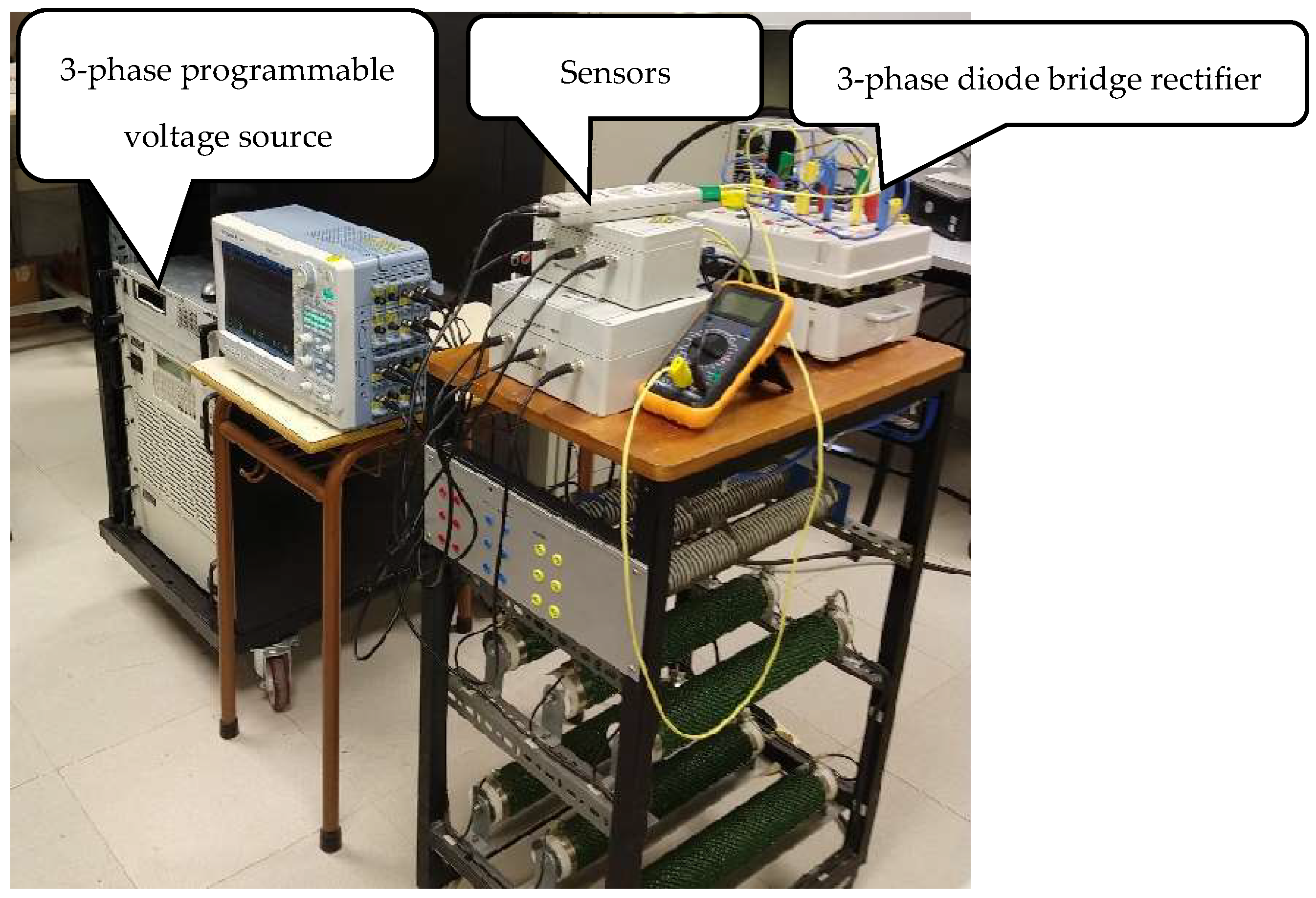
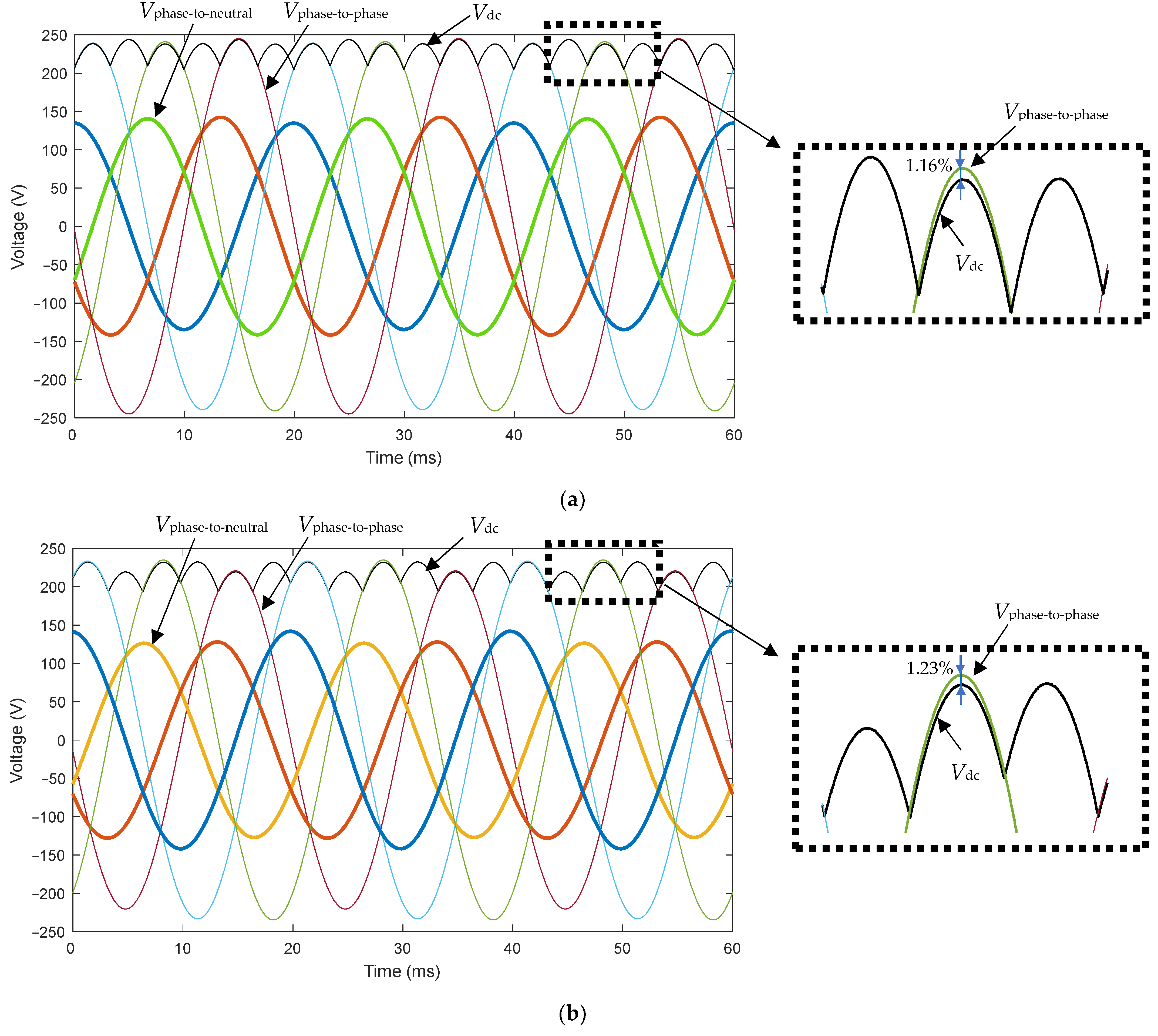

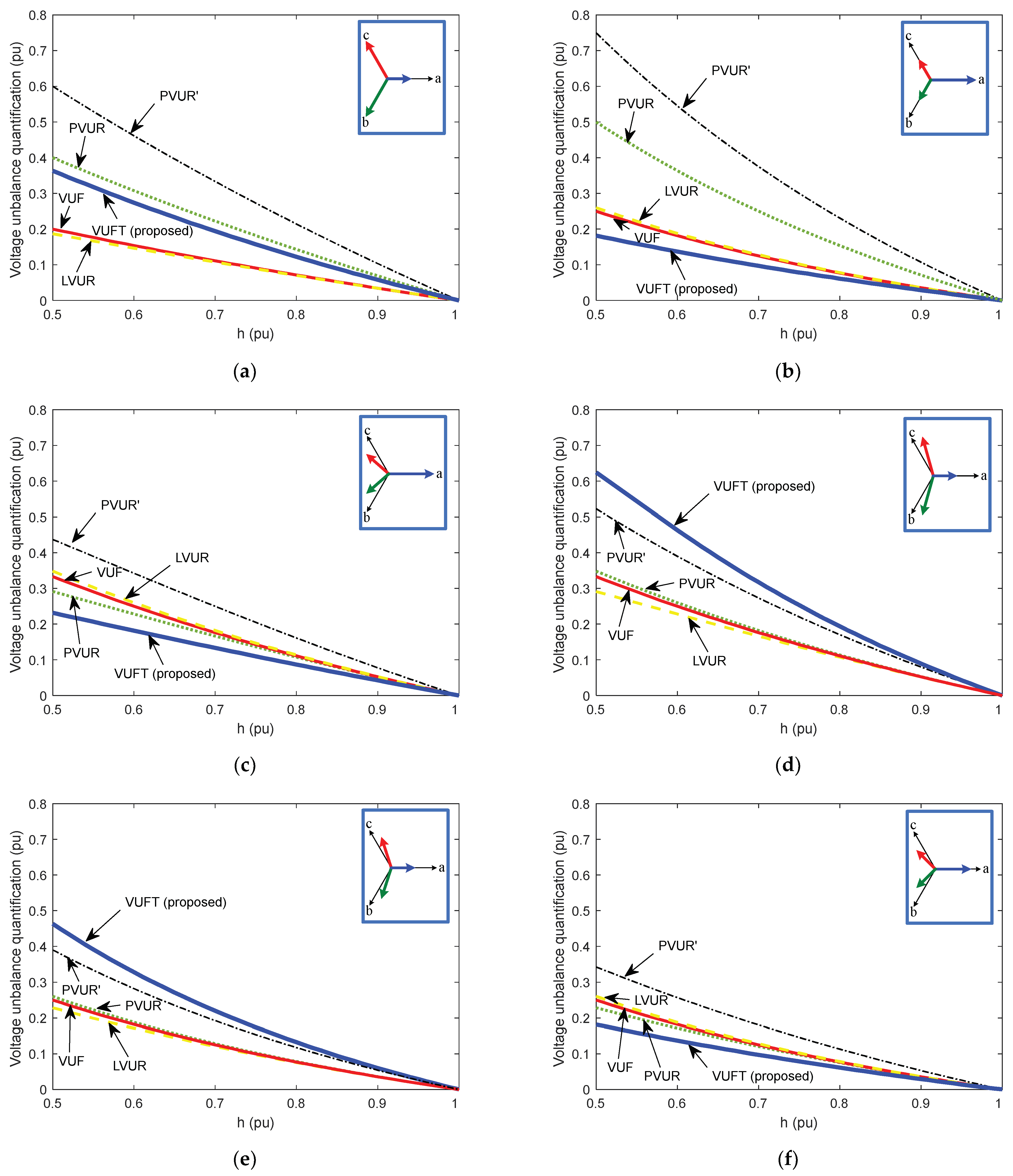
| Voltage Unbalance | Phasor Expressions | Positive Seq. 1 | Negative Seq. 1 | VUF 2 |
|---|---|---|---|---|
 | ||||
 | ||||
 | ||||
 | ||||
 | ||||
 |
| Voltage Unbalance | LVUR 1 | PVUR 2 | PVUR’ 3 |
|---|---|---|---|
 | |||
 | |||
 | |||
 | |||
 | |||
 |
| Meas. 1 | tmin 1 (ms) | Vmax 1 (V) | tmin 2 (ms) | Vmax 2 (V) | tmin 3 (ms) | Vmax 3 (V) | tmin 4 (ms) |
|---|---|---|---|---|---|---|---|
| M1 | 3.36 | 243.69 | 6.65 | 237.88 | 9.94 | 238.27 | 13.36 |
| M2 | 13.36 | 243.73 | 16.65 | 238.04 | 19.94 | 238.27 | 23.36 |
| M3 | 23.36 | 243.73 | 26.65 | 237.92 | 29.94 | 238.25 | 33.36 |
| M4 | 33.36 | 243.75 | 36.65 | 238.04 | 39.94 | 238.27 | 43.36 |
| M5 | 43.36 | 243.75 | 46.65 | 237.9 | 49.94 | 238.27 | 53.36 |
| M6 | 53.36 | 243.71 | 56.65 | 237.9 | 59.94 | 238.31 | 63.36 |
| M7 | 63.36 | 243.69 | 66.65 | 237.94 | 69.94 | 238.38 | 73.36 |
| M8 | 73.36 | 243.67 | 76.65 | 238.00 | 79.94 | 238.27 | 83.36 |
| M9 | 83.36 | 243.71 | 86.65 | 237.92 | 89.94 | 238.29 | 93.36 |
| M10 | 93.36 | 243.75 | 96.65 | 238.04 | 99.94 | 238.29 | 103.36 |
Publisher’s Note: MDPI stays neutral with regard to jurisdictional claims in published maps and institutional affiliations. |
© 2022 by the authors. Licensee MDPI, Basel, Switzerland. This article is an open access article distributed under the terms and conditions of the Creative Commons Attribution (CC BY) license (https://creativecommons.org/licenses/by/4.0/).
Share and Cite
Bogarra, S.; Saura, J.; Rolán, A. New Smart Sensor for Voltage Unbalance Measurements in Electrical Power Systems. Sensors 2022, 22, 8236. https://doi.org/10.3390/s22218236
Bogarra S, Saura J, Rolán A. New Smart Sensor for Voltage Unbalance Measurements in Electrical Power Systems. Sensors. 2022; 22(21):8236. https://doi.org/10.3390/s22218236
Chicago/Turabian StyleBogarra, Santiago, Jaime Saura, and Alejandro Rolán. 2022. "New Smart Sensor for Voltage Unbalance Measurements in Electrical Power Systems" Sensors 22, no. 21: 8236. https://doi.org/10.3390/s22218236
APA StyleBogarra, S., Saura, J., & Rolán, A. (2022). New Smart Sensor for Voltage Unbalance Measurements in Electrical Power Systems. Sensors, 22(21), 8236. https://doi.org/10.3390/s22218236






